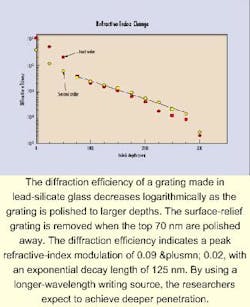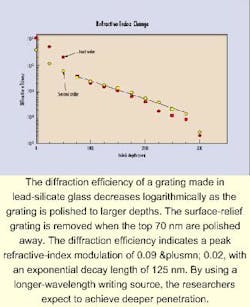Lead-silicate glasses offer higher-efficiency fiber gratings
Researchers at the University of New Mexico at Albuquerque (UNM) are developing lead glasses that offer more efficient diffraction gratings than the germanosilicate glasses currently used for fiber gratings. The glasses show a large photosensitivity--a long-term change in the refractive index when exposed to ultraviolet light, which is exactly the property needed for creating diffraction gratings in fibers.
Diffraction efficiencies as high as 10% were recently reported by Steven Brueck and Xiangcun Long at UNM's Center for High Technology Materials in the publication Applied Physics Letters (April 12, 1999, p. 2110). More efficient gratings in fibers could allow the use of shorter and therefore cheaper gratings. Alternatively, devices with multiple gratings could be stacked without becoming prohibitively long.Glasses that contain lead are common, off-the-shelf materials. But "as far as we know," Brueck says, "their photosensitivity hasn't been measured before." At the moment, germanosilicate fibers have an index difference between the irradiated and nonirradiated material of about 0.01 for hydrogen-loaded fibers. Long and Brueck have measured refractive-index differences in lead-silicate glasses as large as 0.09, which is the highest index change reported for any glass, to the best of their knowledge (see Figure). In an as-yet unpublished work, Brueck says they demonstrated refractive-index changes as large as 0.2 for a glass that contains 56 mole % lead.
The researchers investigated a number of common glasses, including F2, SF11, SF6, and ZF7. The first gratings were made using a phase mask and a krypton flouride (KrF) excimer laser operating at 248 nm. They found that ZF7 is photosensitive across a wide spectral region that includes 193 nm (such as from an argon flouride excimer laser) and, more significantly, 266 nm (the fourth harmonic of a Nd:YAG laser). The KrF laser irradiation results in both an index change and a surface relief grating about 70 nm thick. When the researchers polished away the surface profile, the diffraction efficiency fell. But the remaining diffraction's efficiency was due to a photosensitive index grating.
The researchers also found that the modulation of the refractive index decreases exponentially with depth because the ZF7 glass absorbs ultraviolet light at 248 nm. Brueck and Long believe that using a longer wavelength, between 300 and 350 nm, would allow much deeper penetration because the material's coefficient of absorption is lower at these wavelengths. "We are predominantly using 266-nm quadrupled YAG" to make gratings now, Brueck reports.
Assuming the same refractive-index change could be achieved with a thickness of 4.2 microns, then gratings could be made with diffraction efficiencies as high as 90%. Researchers at the Center for High Technology Materials have discovered that the change in refractive index is exponential to the lead fraction by volume at least up to 56 mole %. By measuring the dispersion of this index change, they showed that the photosensitivity is associated with changes in the bulk glass absorption edge. This situation is very different from the usual case of hydrogen-loaded germanosilicate fibers, in which the photosensitivity is associated with bleaching of a germanium impurity absorption.
Another promising aspect of the work is the thermal stability of the new material. The currently used hydrogen-loaded glasses are very sensitive to temperature. In contrast, the researchers heated the lead-glass gratings to more than 300ºC for longer than an hour, without any change in the index difference in the gratings.
Although the lead glasses are not typically drawn into fibers, there is no fundamental reason why they could not be used in making fibers, until the lead concentration becomes very high.

